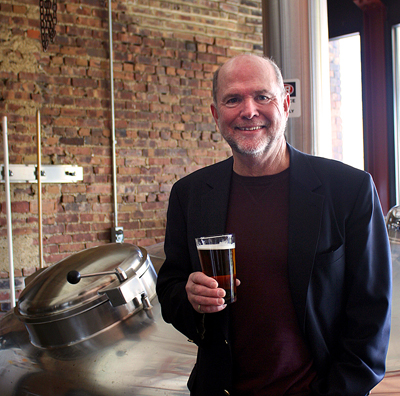All About Beer: The words “environmentally and socially-conscious” appear first in a list of attributes that describe your company. Where did that commitment start?
Pat Conway: It’s been an evolution. My brother Dan and I almost immediately had a recycling effort at the brewery back 24 years ago. Now we have the three waves in our logo. The logo has barley crisscrossed at the top, centered with hop cones. Underneath the words “Great Lakes Brewing” we have three waves that represent our Triple Bottom Line: we felt it was important to emphasize, beyond the financial, the social and environmental. As it’s turned out over the years, the social and environmental aspects have gained in popularity with our consumer base.
We’re part of the one-percent-to-the-planet strategy giving back to the community. We’ve got our Burning River Fest, which I think is going into its twelfth year, where we give money to groups that work primarily in the area of water quality. I think we’ve doled out over $350,000 to groups that work in that sphere. So it’s not “green-washing”: it’s a living, breathing part of the company.
Great Lakes is located in a historic part of Cleveland.
The buildings were actually built in the mid-nineteenth century. One was a livery stable, which is now our beer garden. Another building where our taproom and beer cellar are, was called Market Tavern. The other building was the Herman-McLean Feed and Seed, and now that’s our little brewery restaurant and dining room. The corner building was the Silver Dollar Saloon and upstairs was a burlesque house—now that’s our corporate offices on the upper floors and the first floor is retail. Our production brewery across the street was the stables of an old brewery called Schlather Brewing Co.
Cleveland had 30 breweries in the 1870s, and we’re in the center of where a lot of the brewing activity took place. The whole campus just reeks of charm. There’s nothing like old red brick buildings to conjure up the romance of brewing days past.
You once told me there are bullet holes in the brewpub wall.
That was Eliot Ness. Our mother was his stenographer. When he put Capone in jail in Chicago, he came to Cleveland to run the police and fire department, and my mom used to take dictation from him. One of his favorite watering holes was Market Tavern. There’s a stunningly beautiful tiger mahogany bar replete with bullet holes: somehow, they’re associated with Ness. My mom questioned the veracity of the story, because she said he never carried a gun, but I said, “Well, maybe somebody shot at him.”










